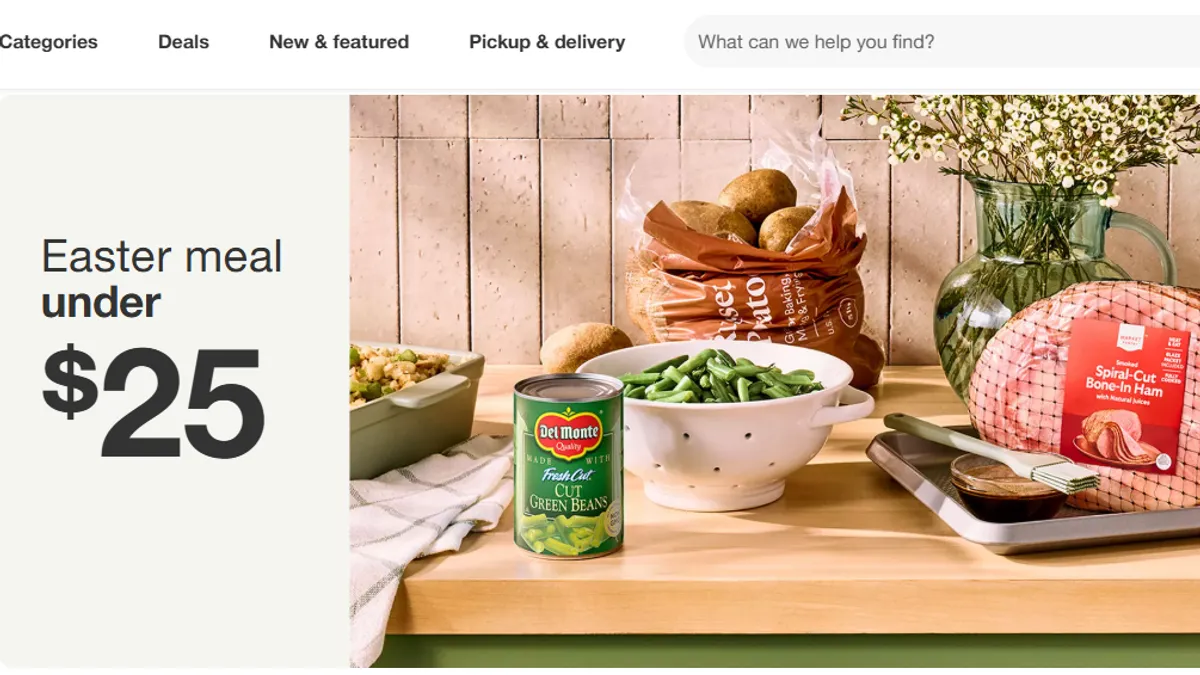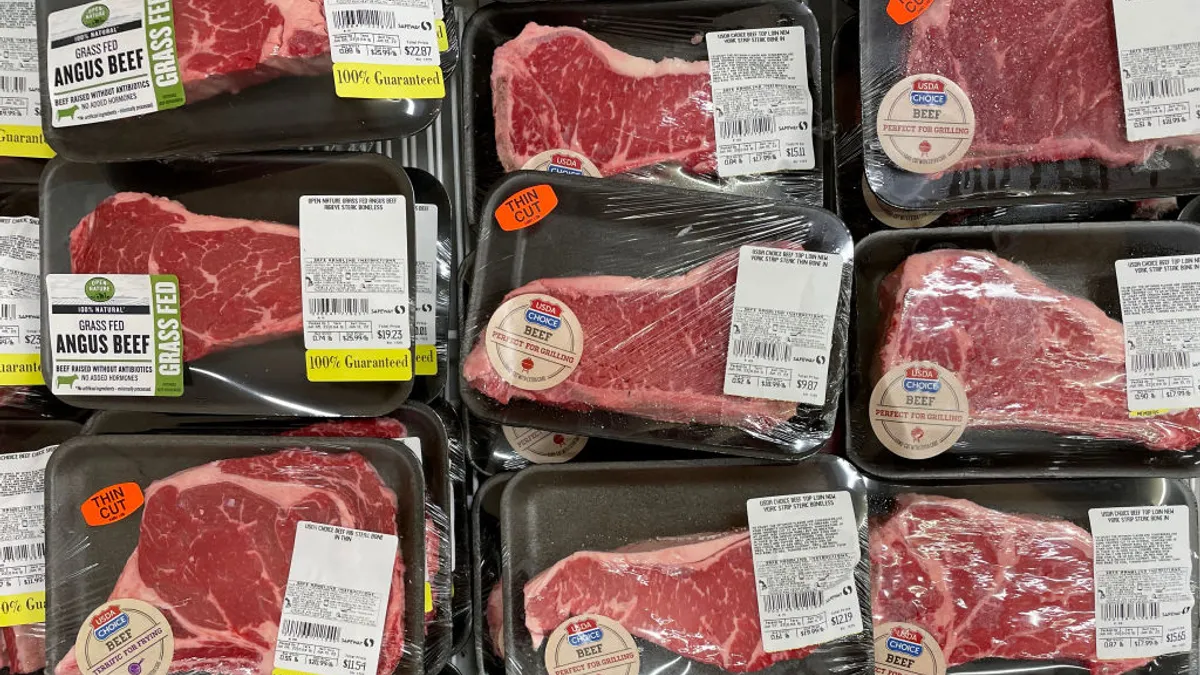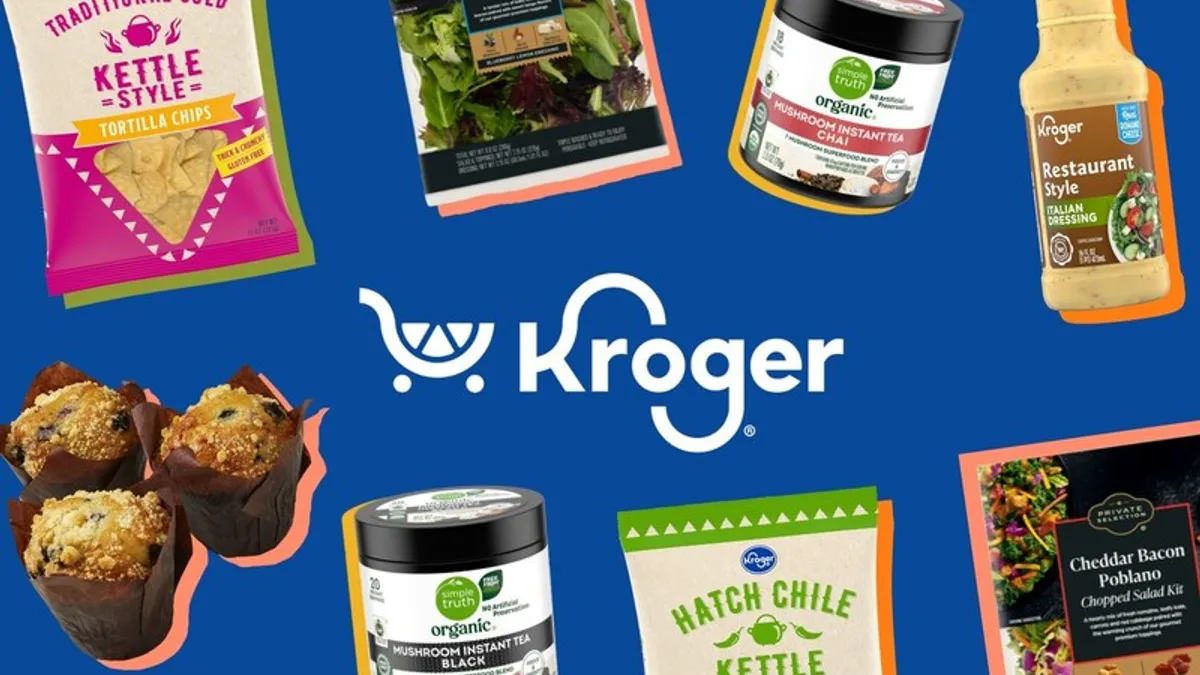In a large field just northeast of Des Moines sits a pair of trailers emblazoned with signs touting the future of "The Shoppes at Prairie Crossing: A mixed use development.”
The largely desolate space in the heart of corn and soybean country isn’t much to look at now. A Fairfield Inn and Suites and a VF Outlet mall are barely visible in the distance. But eventually the area will transform into a sprawling modern landscape complete with a strip mall, a hotel, condos, restaurants and numerous other establishments.
The site does have one current tenant: Hy-Vee Fast & Fresh, the Midwest grocer’s updated take on the convenience store. The brightly lit, 10,000-square-foot location offers donuts, chips and candy bars along with fresh meals, produce and a few upscale offerings, like a $75 bottle of Cody Road Rye Whiskey. Shoppers can pick up their online grocery orders in bright red Aisles Online lockers outside.
It might seem odd to place a cutting-edge store off near a field by itself. But Antonio Romeo, the store’s director, said he sees an opportunity to get the location established before the neighbors arrive.
"We're just a little early out here for everything that's going to happen. It wasn't by accident," Romeo said.
To draw shoppers and get them in the habit of returning, Fast & Fresh features four aisles of wine and spirits, a walk-in beer cave and 12 local craft beers on tap that consumers can fill up in their Hy-Vee branded growlers and crowlers. Romeo posts on Facebook when new brews are added, even though he doesn't use the social networking site personally.
The grab-and-go section provides an extensive selection that includes Hy-Vee meal kits like ciabatta steak sandwiches and chicken cavatappi with vegetables, and pre-packaged meals of goulash, lasagna, beef enchiladas, sweet potato and kale chicken bowls, grilled salmon with long grain rice, and cheesecake.
The Mia Pizza station with its wood-fired oven does more in sales than the same concept housed in 14 other traditional Hy-Vee stores, including a 95,000-square-foot flagship 26 miles away that is the banner's top-grossing location. Romeo credits aggressive promotions, including a buy one, get one pizza coupon sent to everyone within a three-mile radius shortly after the Fast & Fresh opened, and a half-off deal for people who have season passes to a nearby amusement park.
"What we do here is more than just the results of this store every month. It's five, 10 years from now, what the Fast & Fresh can be," said Romeo.
Fast and Fresh isn’t the only slimmed-down concept Hy-Vee is testing. Just a few miles away, HealthMarket sells kombucha, cauliflower pizza crust, probiotics, fresh produce and lighter offerings from major brands like Ben & Jerry's. In downtown Des Moines, Fourth + Court, which opened in 2017, caters to young shoppers and empty nesters alike, many of whom live in the three-story apartment building above the store.
"There's a lot of talk over what the store of the future is going to look like," Randy Edeker, Hy-Vee's CEO told Grocery Dive in February. "I don't think anybody knows but we have to experiment a little bit."
Fresh & not so easy
Anticipating, testing, probing, expanding. Amid depressingly low margins and a competitive squeeze that promises to keep tightening, traditional grocers like Hy-Vee are trying to take back control with experimental formats that address weaknesses in their legacy stores — namely, speed and convenience.
Publix recently reignited its Greenwise format, with three locations open and eight more announced. Giant has touted the early success of its urban format, Giant Heirloom Market, in Philadelphia, while Roche Bros. in the northeast has moved into population-dense areas with its Brothers Marketplace format, now at four locations.
"What we do here is more than just the results of this store every month. It's five, 10 years from now, what the Fast & Fresh can be."

Antonio Romeo
Store director, Hy-Vee's Fast & Fresh
The fresh-focused convenience store has caught on with Kroger and Albertsons, both of which are testing new formats. Midwest retailer Meijer rolled out Bridge Street Market in Michigan last year, and is now preparing to open Woodward Corner Market in Detroit. At roughly 40,000 square feet each, the new retail spots are a far cry from the company's average store size of 200,000 square feet.
By building smaller, more focused stores centered on in-demand products, grocers have the opportunity to enter new markets and give their brand a facelift. But analysts who follow the industry paint a more cautious picture: Grocers, they say, have little choice but to forge ahead with new concepts, and there is no real consensus as to what will ultimately prove successful.
Burt Flickinger, managing director of the Strategic Resource Group, told Grocery Dive the U.S. is 15 years behind countries such as England, Scotland and Germany when it comes to innovation and new grocery store concepts. To increase the likelihood that test formats in the U.S. payoff, he said new concepts need to shift their product mix away from brand names while targeting more of their advertising and communication efforts locally to make themselves a more ingrained part of the community.
"I'm cautiously hopeful but based on the history in the U.S. of the major retailers over the last year 15 to 20 years [I'm] hoping for the best but fearing that these entrepreneurial initiatives may not get to the size, scale and scope that" grocers need, Flickinger said. "The U.S. is getting better but it has a long way to go."
Neil Saunders, managing director with Global Data, said even though grocers are cognizant of the trends impacting consumers and the industry as a whole, there are a host of reasons why many struggle to successfully debut a new concept — and why when they do find one that works, they take a slow and methodical approach in rolling it out.
Saunders pointed to Tesco, which quickly ramped up its Fresh & Easy format rather than testing it in one or two markets first. The U.K.-based retailer soon found that its British-style ready meals, store locations and a heavy assortment of Fresh & Easy-branded products didn't resonate with U.S. shoppers. The experiment cost Tesco more than $1.6 billion. It ultimately exited the U.S. in 2013 and sold off the remaining stores.
Saunders said these prior failures "throw caution into the marketplace because people say 'Look, these things haven't always worked.' "
Other grocery offshoots have struggled to expand. Main & Vine, Kroger’s experimental small-store concept that focused on fresh and local foods, closed in Washington State in 2018 after two years. Stop & Shop halted development of its Bfresh concept that highlighted fresh produce, natural and organic products and prepared foods. Earlier this year, Whole Foods pulled the plug on its small, low-frills 365 by Whole Foods stores.
Even Walmart, the nation's largest retailer, has struggled with small stores. The company shuttered its 102 Walmart Express stores in 2016, and growth of its Neighborhood Market concept has slowed in recent years.
"Retail is testing, trying out new formats, looking at things that might work," Saunders said. "I think that will [slow down] over the next three or four years and we’ll actually start to see a more concrete roll out of some of these formats, not all of them being experimented at the moment will work.”
Learning from the past
Although Stop & Shop’s Bfresh format has struggled, Ahold Delhaize is confident it has learned from the experience.
In developing Giant Heirloom Market, Paul Madarieta, director of growth initiatives at Giant Food Stores, said the company drew inspiration from its stores domestically and in Europe, where parent company Ahold Delhaize is headquartered.
The signage and store design were inspired by its Dutch supermarket chain Albert Heijn and U.S. banner Stop & Shop, while some elements of a small concept store were taken from its Hannaford brand. Giant even went outside the company for inspiration, turning to the Reading Terminal Market in Philadelphia and Eataly, the Italian-inspired concept known for its high-quality food.
Scaling down meant streamlining its assortment. At a traditional Giant store, energy bars would be stocked in one aisle while natural ones would be placed in a different area, Madrieta said. Giant Heirloom combined them into one display. Shelf-stable salad dressing, which is commonly sold in the condiment aisle, was put next to refrigerated dressings and lettuce to make it easier for shoppers to grab and go. And plant-based items typically scattered throughout a store have been combined into a single department — a design Ahold Delhaize is looking to bring to other banners throughout the company.
If customers can't find what they're looking for, they can use a digital kiosk to order from Giant's full online assortment via Giant Direct, Powered by Peapod.
"When you start asking yourself what does the customer want, it helps you make much better decisions," Madarieta told Grocery Dive. "And if the decision goes against the grain of what we normally would do in a traditional store then maybe the right thing to do is break that tradition. That is what we tried to do."
Madarieta, who worked at Trader Joe's for 20 years followed by a stint at Fresh & Easy, said Giant took a close look at the Bfresh chain to see what didn't work.
Unlike Bfresh, which had workers specialize in one area of the store, Giant Heirloom trains employees to be versatile in doing everything from running the register to staffing the deli and dolling out advice about beer and wine. It also did away with ovens in the bakery section, instead using the space to offer a larger selection of bread supplied by local businesses. The meat and seafood departments were overhauled to prioritize prepacked offerings similar to those popular at Trader Joe's, providing additional convenience without the need for costly labor to staff them.
Even the way employees are interviewed has changed. Whether it's a bagger or store manager, job candidates are asked about their favorite meal and what they would prepare for the interviewer if they were coming over for dinner. This ensures individuals are really passionate about food.
"We really wanted to make sure that we learned from Bfresh, things that kind of took them off of what they were trying to do," Madarieta said. "We very much viewed [Giant Heirloom] as a startup."
Currently, Giant operates two 10,000-square-foot Heirloom Markets in Philadelphia, with two more slated to open in the city's Northern Liberties and Queen Village neighborhood.
The prior failures "throw caution into the marketplace because people say 'Look, these things haven't always worked.' "

Neil Saunders
Managing director, GlobalData Retail
One store at a time
One company that has avoided the pitfalls that have beset some of its competitors is Roche Bros. The 67-year old New England supermarket chain opened its first Brothers Marketplace offshoot in 2014 as a way to expand and separate itself from nearby competition. The banner, whose stores are about 10,000 to 15,000-square feet in size, opened its fourth location last month.
Arthur Ackles, vice president of merchandising and buying at Roche, told Grocery Dive the company likes to target small towns and population-dense urban areas with minimal competition, allowing the grocer to employ a smaller footprint while also becoming the neighborhood shop for local residents.
Its first store in Medfield, Massachusetts, a rural middle- to upper-class community of about 13,000 people southwest of Boston, is situated in the heart of downtown inside a former department store. A church sits across the street, while a local brick oven pizza shop, barber and jeweler reside in the building next door. There's not a lot of opportunity for development within a three-to-five mile radius, especially for a big-box retailer like Wegmans, and much of what's already built nearby is residential, Ackles said.
Similar characteristics are evident in its new location in Duxbury, a seaside community in Massachusetts. Area businesses, some of them just down the block, sell their sea salt, baked goods, pepper sauce and protein bars in the store.
But rural areas aren't the only focus for the banner. Roche is planning to open a new Brothers Marketplace on the ground floor of a building owned by the Massachusetts Institute of Technology in Cambridge this fall, giving a neighborhood that is home to 50,000 life sciences and technology workers and a growing residential population a long-awaited grocery store.
Ackles said the company doesn't have plans to open up additional Brothers Marketplace locations in 2020 after adding two this year, noting they "were great opportunities that we shouldn't pass up." Developers routinely ask the company to put a Brothers Marketplace in as an anchor in a residential area, but the request is often turned down. He said Roche needs to consider the time, capital and effort to operate its current base of stores, as well as making sure any new locations have the right demographic and population density to be successful.
“We’re getting opportunities left and right, which is nice because it allows us to kind of be picky about where we go and where we don't," Ackles said.
Grocers in demand
Rick Weinberg, executive vice president of commercial real estate services and investment at CBRE, said grocery is the top requested amenity in an urban residential development. A supermarket helps attract tenants to the building while filling up a key space for the landlord at the street level. The grocery chain benefits by gaining a foothold in a population-dense area, and doing so with a smaller, less cost-intensive real estate foot print.
"It's a good mix. It's a good marriage. And it is something that developers very much want as part of their projects," Weinberg told Grocery Dive.
Real estate research firm JLL Group noted grocery store openings were up 30% last year compared to 2017, driven largely by small-store openings.
Much of that small-store growth, however, is being driven by specialists like Aldi, Grocery Outlet and Sprouts Farmers Market. As grocers hone their scaled-down stores, they're in a race not just to meet consumer demand but also to blunt the impact of these operators. Aldi, for one, currently operates around 1,900 stores and plans to have 2,500 operating by 2022.
“The size of the stores continues to change and that happens until somebody gets it right and then somebody else will copy it," Weinberg said. "It really is a measure of the evolving state of retail and things are changing quickly and the retailers that are able to evolve and change are going to be successful.”
As the mix of failures and successes prove, finding a winning format is anything but a sure thing.
Consumers can be fickle and a sure-fire concept could inexplicably fail, grocery experts said. It's also hard to set operations for locations that have different staffing requirements compared to a regular store along with a more limited product mix. This often necessitates a constant adjustment of what is sold and how and where it is displayed. And the supermarket industry has been notoriously slow to innovate, Saunders noted, preferring to do the same store with the same levels of product mix, staffing and financial predictability.
“If you think you know it all, if you think you have the perfect platform and nothing else matters, you're not going to succeed."

Arthur Ackles
Vice president of merchandising and buying, Roche Bros.
Today, the rapid pace of change in the grocery industry has made supermarket owners more willing to experiment and try new things, even if that means confronting the very real risk of failing.
“Even now as we’re doing this, there is still a lot of trial and error but you got to be able to be open to ideas and open to what the customer is looking for and learn from it and then incorporate that moving forward," said Ackles with Brothers Marketplace. "If you think you know it all, if you think you have the perfect platform and nothing else matters, you're not going to succeed. ... What’s popular today, and what’s hip today, tomorrow may not be. You got to have the flexibility to change.”





















